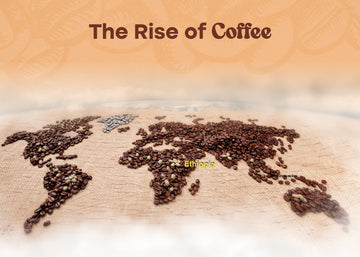The Spread of Coffee throughout the World
Coffee is considered one of the most beloved beverages worldwide. Its rich and fascinating history dates back centuries. Its journey from wild beans to a worldwide staple is filled with adventure, culture, and a touch of legend.
The Legend of Kaldi and the Dancing Goat
The most popular narrative about the discovery of coffee dates back to the 9th century and involves an Ethiopian goat herder named Kaldi. According to the tale, Kaldi noticed his goats becoming particularly energetic after eating the red berries from a particular tree. After that, he tried the berries and experienced a similar burst of energy. Excited by his discovery, Kaldi shares the berries with a local monk, who used to stay awake during long hours of prayers. This tale is probably more myth than fact, but it introduces the coffee’s journey from Ethiopia to the rest of the world.
Coffee’s Ethiopian Roots
Maybe the story of Kaldi is true because Ethiopia is considered the birthplace of coffee. The coffee plant, Coffea Arabica, is native to the Ethiopian highlands. For centuries, the Oromo people of Ethiopia are believed to have chewed coffee beans for energy. They also made a paste from the beans and mixed it with animal fat to create a high-energy snack.
Coffee Spreads to the Arab World
Coffee’s journey from Ethiopia to the Arab world began in the 15th century. Yemeni traders brought coffee beans back to Yemen, where the drink quickly gained popularity. The first known coffee cultivation and trade started in the Yemeni Port City of Mocha. Sufi monks in Yemen used coffee for its stimulating effects, which helped them stay alert during long nights of prayers and meditation.
By the 16th century, coffee had spread to Persia, Egypt, and the Ottoman Empire. Coffeehouses, called Qahveh Khaneh, began to appear in cities throughout the Middle East. These coffeehouses became key social centers where people gathered to drink coffee, listen to music, play chess, and discuss politics.
Coffee Reaches Europe
Coffee reached Europe in the 17th century. Venetian merchants, who traded with the Ottoman Empire, were some of the first Europeans to come across coffee. Initially, coffee was met with suspicion and even called "the bitter invention of Satan" by some clergymen. However, Pope Clement VIII is said to have tasted it, liked it, and declared it a Christian drink.
Coffeehouses soon became popular throughout Europe, especially in cities like Venice, London, and Paris. These places were called "penny universities" in England because they were hubs for intellectual and social activities. The first coffeehouse in England opened in Oxford in 1650, followed by London's famous coffeehouses such as Lloyd's, which eventually became Lloyd's of London, a significant insurance market.
Coffee in America
Coffee came to America during the colonial era. The French introduced coffee plants to the Caribbean island of Martinique in the early 1700s, and from there, coffee spread to Central and South America. Brazil, with its ideal climate and extensive plantations, became a leading coffee producer by the 1800s. Today, Brazil stands as the world's largest coffee producer.
The Modern Coffee Industry
In the 20th and 21st centuries, coffee has transformed from a trade item of colonial times into a worldwide cultural sensation. The emergence of specialty coffee, fair trade principles, and the third-wave coffee movement have all played roles in revitalizing interest in coffee's beginnings and the craftsmanship required to produce it.
Specialty coffee shops, barista contests, and coffee festivals highlight coffee's variety and intricacies. Consumers are more curious about the narratives behind their coffee, including the growers and the eco-friendly methods used in farming.
Conclusion
From the legendary tale of Kaldi and his energetic goats to coffee's role as a worldwide cultural symbol, its history is as rich and intricate as its taste. Its path from Ethiopia's mountains to coffee shops worldwide mirrors centuries of trade, exploration, and cultural sharing. Whether you prefer plain black coffee or a carefully made espresso, each sip connects you to an intriguing history and a lively present.
Further reads: A deep dive into unroasted beans



